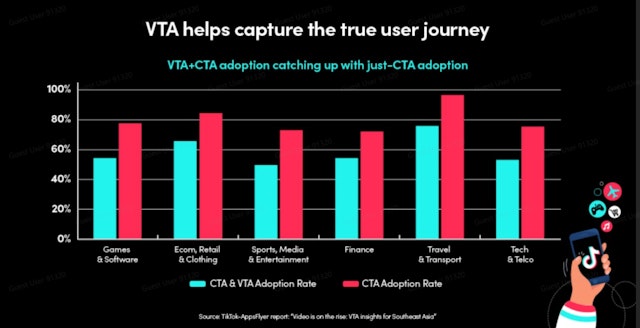How outdated attribution strategies harm ad performance on TikTok
Marketers have been moving spend into digital video ads as audiences flock to entertainment platforms such as TikTok. But key to getting the most return on ad spend from online videos is having the right attribution model.

How outdated attribution strategies harm ad performance on TikTok
According to a joint report by AppsFlyer and TikTok, video accounts for 40% of all programmatic ad spend in South East Asia, representing a major shift in investment for advertisers. Yet there’s still a considerable opportunity for brands that is being missed due to outdated approaches to attribution.
The AppsFlyer-TikTok whitepaper noted that marketers are currently focused on click-through-attribution (CTA). As video ad formats become more immersive, incorporating view-through-attribution (VTA) can improve media spend efficiency and give a more holistic view of the consumer conversion funnel.
The report looked at short-form video platform TikTok to understand consumer behavior of South East Asian users in relation to ads. A study by NielsenIQ found that because video formats have become more engaging, users don’t click out of the platform immediately. These same users are also expected to engage with brands in more meaningful ways, and are 1.5x more likely to purchase an item after seeing an ad on TikTok.
User action taken may be delayed, which means that relying on an attribution model purely on clicks would give advertisers a warped sense of what drove action, eventually reinvesting in the wrong channels. By adding VTA into the mix, advertisers are able to understand the full impact of their content on consumer behavior.
Some brands are already using this combined approach. According to the report, there has been an increased adoption of VTA among e-commerce, tech and media, and entertainment advertisers in South East Asia from October 2020 to April 2021.

For the TikTok platform specifically, the report looked at how combining CTA and VTA allowed for signals to be passed back for optimization. According to the report, the combination meant more signals were passed back, and this accelerated the learning phase and improved optimization considerably.
Within South East Asia, the verticals with the highest combined CTA + VTA metric are e-commerce, media and entertainment, and finance. These categories are able to optimize their ads up to 113% faster, while maintaining low fluctuation in their spend.
The report also shared that with Apple’s App Tracking Transparency (ATT) prompt released earlier in April, TikTok will continue to support VTA, thus ensuring advertisers would be able to look at their attribution model on a holistic view of ‘CTA+VTA’.
To find out more about how you can adapt your attribution toward a combined CTA and VTA model, download the AppsFlyer-TikTok Video is on the rise: VTA insights for South East Asia report for free.
Content created with:

TikTok
TikTok is the leading destination for short-form mobile video. Our mission is to inspire creativity and bring joy. TikTok has global offices including Los Angeles,...
Find out more